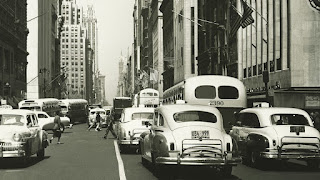 |
| Why nostalgia for the past is in the American DNA |
If you could live in any era since the
founding of our country, when would it be? When asked this question, the
majority of my friends will usually say either the ’80s or the early ’90s. My
parents preferred the ’50s and ’60s, and, naturally, my grandmother used to say
she’d love to go back to the Roaring Twenties. Reliving our faded youth is a
universal desire, but Americans seem to be especially enamored with the past,
and not just from our own lifetimes. We are collectively nostalgic
for all that is retro, pining over certain eras we long for, and that we
occasionally attempt to recreate.
Sometimes, our nostalgia is about
aesthetics, such as our obsession with mid-century furniture, vintage clothing,
and pre-war houses. Sometimes it’s about a mood, as well, which is why we have
entire California and Arizona towns
restored to replicate the Wild West.
In the South, we entertain an ongoing obsession with Civil War reenactments and antebellum homes. For a nation that is presumed to be ignorant of history, we sure do love our own (except the history we should learn from and not repeat, but that’s a different article). Asking each other which point in our national timeline we would return to if we could, is a common conversation I’ve taken part in and overheard dozens of times. It’s as though Americans feel that the height of happiness always belongs both in and to another time. Any time but the present.
In the
early 2000s, I recall my college buddies going to nightly swing dancing clubs,
and girls would walk around campus in flapper dresses purchased from one of the
dozens of vintage shops downtown. Today, those same friends fawn over ’70s
vinyl with stars in their eyes for an era they never knew personally but feel
certain must have been magical. They hold ’80s dance parties in their living
rooms (puffy hair and shoulder pads are still optional, fortunately) and
everyone agrees, wholeheartedly, that “life was so much better back then.” And
maybe it was. Ronald
Reagan was president and our economy was booming, after all. Wokeness
hadn’t yet inserted its demented hivemind onto the scene, so you couldn’t get
fired for using the wrong pronouns. We were all in love with The Breakfast Club
and a talking alien named ALF. Life was good.
Personally,
I have the most nostalgia for the early to mid-’50s (it doesn’t matter that I
wasn’t born until ‘78) and I’m fortunate to live in a neighborhood with original
’50s diners, little pink houses, and an antique car show. Sometimes, I like
to imagine I live in one of the houses with a white picket fence, it’s 1955,
and I’ll wake up to retrieve the daily newspaper from the driveway instead of
powering up my Macbook. And I’m not alone. Besides the ’80s, 1950s America is a
popular decade to fantasize and write fiction about, as evidenced by a long
list of TV shows and movies not made but set in that time period.
But why are we so hungry for the past? It could, in part, be because of the influence of Hollywood and the period films it often creates and recreates. I’ll admit we’re a nation of consumers.
It may also be that, as a very young
country, we want to preserve and relish our relatively short but exciting
history. Some of that history is ingrained in our culture and preserved by way
of the Western saloons, trains, and diners that still dot the landscape. These
things hold meaning beyond facts and points of reference. We don’t just love
the history
of Tombstone, but the rugged individuality it represents. And wouldn’t it
be something, after all, to be able to go back to it? To a time when we were
forging new territory, and opportunity loomed large in the golden desert
landscape? When we could literally strike oil or find gold in them their hills?
Sure, you might get killed in a shootout, but that’s no worse than in Los
Angeles in 2022. The difference is that, back in those days, we had real
cowboys and the kind of men who wore gun holsters, not man buns. It was
glorious.
You might be rolling your eyes at how
naïve we are to look at the past in this way, through rose-colored – or should
I say golden-hued – glasses. Some might say it’s hopelessly romantic and
unrealistic. Every generation has its struggles, after all, and some were more
difficult than others. That’s the more reasonable view, I suppose. A few points
in time were truly great, but they didn’t last forever, as nothing does. The idealism of 1950s America
gave way to the Vietnam War, eventually, and the flower children of the ’60s
had to finally grow up and get real jobs. Times change, and so does society.
Still, our longing to return to certain
grand old times that stand out prominently on our cultural landscape – whether
it’s the Wild West, the suburbs of the 1950s, or 1985 Yuppiville - is part of
the American DNA. These eras mark times when we were prospering as individuals
and as a country, and when we felt safe and secure. And we were secure. We were
happy. And even if we weren’t happy, we can remember those times as if we were
– especially if we weren’t alive. In fact, not being around to have experienced
any disappointments along with all the greatness is what crystallizes how
wonderful any particular time truly was. Because then, and only then, can we
cling to the old pictures and hold suspended in our minds an idea of our
happiness. Which is almost better than happiness itself.
Written by
Memoree Joelle
Memoree Joelle is a writer and constitutional conservative living in Los Angeles.
Think your
friends would be interested? Share this story!
( Keywords )


إرسال تعليق